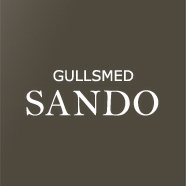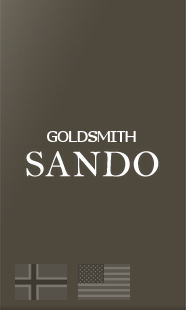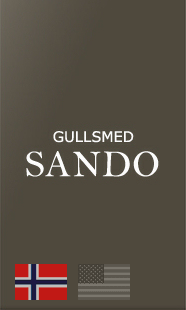The tale of Goldsmith K. E. Sando, the oldest business in Rjukan
It all began in Hallingdal, in the end of the 1800's. In a place called Ål was the Sando farm, and on this farm there was a young man called Kolbjørn. Kolbjørn was the oldest of Guri and Eiriks 12 children. As the farm heir, Kolbjørn had to learn everything there was to know about running a farm, but he was more interested in learning his way around the forge. His father Eirik was not fond of him doing so, and so he started to lock the door to the forge. But it wasn't shut for long, as Kolbjørn made himself another key and sneaked in to the smithy at night time - he wanted to be a goldsmith. Then finally one day, backed up by his mothers support and understanding, he renounced his right to inherit the farm and started a shop in Nesbyen. This was in 1901, and Kolbjørn was 27 years old.
The first couple of years, filigree was in fashion - thread-work both for Bunad silver and clothing accessories for the fashionable city dames. At one point, he had four workers in his shop. It was in this period of time he married Karoline from Sandsvær, with whom he came to have 5 children.
But fashion was ever changing then, as now, and it became more difficult to sell to the merchants in Kristiania (Oslo). Kolbjørn noticed that times were good in Telemark, the neighbor county, where Hydro's establishment in Tinn municipality had made Rjukan grow to 12 000 residents. It had become a tough place, full of rough "rallare" (navvys). Power plants and fabrics were built, and kilometer upon kilometer of tunnels was hollowed out by hand. The navvys had a piece work contract - 4 øre per 2.5 cm meant a lot of money. In 1911 Kolbjørn bought a goldsmith and watchmaker shop here, and built a house so his family could move there in 1912.
A blooming society
Rjukan was a blooming society, with good prospects to grow even more, and for a period of time, Kolbjørn ran a goldsmith and watchmaker business, a soda fabric, a steam laundry, and a quarry. In addition to this, he was the head of the school board. He was so engaged in his work that he often fell asleep in his shop late at night. Then Karoline had to go get him saying "Nå får du komma hjem og sova, Kolbjørn!" (Ye' better get yourself home n'sleep now, Kolbjørn!) Sadly, Kolbjørn was in poor health, and despite a larger operation in 1915, he died in 1923, only 48 years old.
At that time, his oldest son, Erik, was 17 years old. He took care of the goldsmith business, and filled his father's shoes well when he got his goldsmith diploma in 1929. In the family, there's a story about the time he drove his new Harley Davidson off the road and into the woods, with his mother in the side cab. They were both all right - although the bike had to be sent by train from Miland to Rjukan - but Eriks mother might have had one or two rather firm comments to share with him afterwards. In 1933 Erik married Sigrid from Mandal and they got their first child, a son named Kolbjørn, in 1938.
Rjukan always was an eldorado for hikers and active people, and in addition to being a rather good tennisplayer and photographer, Erik was an eager hiker and hunter. He was a Krag marksman until the war broke out in 1940, when all firearms, radios and cars were removed. (When Hardangervidda was patrolled looking for saboteurs the NS requisitioned skis, boots, ski poles and two wool blankets. The family still has the receipt for it, but the equipment was never given back.)
Third generation
After the war, Hydro bloomed all over again in Rjukan, and in 1954, the third generation began its turn in the goldsmith business. Kolbjørn was 16 when he started the goldsmith educational studies in Oslo. After finishing school and apprenticeship, Kolbjørn continued with a two year educational studies in gemstones, or gemology as it is named, and became the youngest in the country with an international graduation in this particular profession. Well back in Rjukan, Kolbjørn was mentored by his father in engraving by hand. Not many know how to do this anymore, as it is mostly done by machines. But in Rjukan, this has become a family tradition with the goldsmiths.
Erik died a sudden death in 1968, not long after handing Kolbjørn the responsibility for the shop. Like his father and fathers' father, Kolbjørn has always been very active in Rjukan's societies and associations, being an elected member of the board in both the Guild of Craftsmen, The Scouts, the local firearms society and The Norwegian Goldsmith Association. He had married Randi in 1960, and they got three sons together. The youngest one was born 1970, a boy named Jørgen, and he started his goldsmith education 1986. Similar to prior generations, he too has got a goldsmith diploma and is a Master Goldsmith.
From 1986 to 2000 K. E. Sando ran a shop both in Rjukan and in Mandal (even two shops in Mandal for a few years). Jørgen was therefore free to choose where to start his future. When he had found Åse in Mandal, content with her wanting to move to Rjukan, he sold the Mandal shop.
Åse and Jørgens first child, Karoline Emilie Sando, was born at the end of 2000 - almost one hundred years after her great great grandfather first used the mark "K. E. Sando" on his work.
Return to the frontpage




